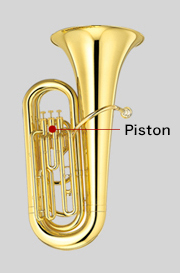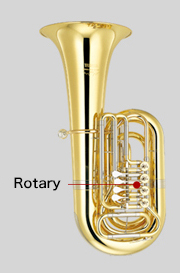There are piston- and rotary-valved tubas. Since maintenance of a piston-valved tuba is the same as for a trumpet, please see the Trumpet Maintenance Manual. Also, since maintenance of a rotary-valved tuba is the same as for a horn, please see the Horn Maintenance Manual.
Care and Maintenance of a Tuba
Basic Care and Maintenance
Care and maintenance of piston and rotary valves

A piston-valved tuba

A rotary-valved tuba
Do not use cleaning fluid or water with a rotary-valved tuba
Please do not use a flexible cleaner for the blowpipe of a rotary-valved tuba. Unlike trumpets and horns, the blowpipe of a rotary-valved tuba is directly connected to the valves, so it is dangerous to insert a flexible cleaner into the blowpipe.
Also, if you are going to flush it with water, do so from the tuning slide. Since the blowpipe collects dirt and grit more easily than any other part of the instrument, inserting a cleaner or flushing water through the blowpipe will send the dirt into the valve and make the valve operate poorly. If you do let water in to flush out the blowpipe, be absolutely sure not to move or depress the valve when you do so. If you depress the valve, dirt in the bypass tube will flow further down into the other valves.
It is fine, however, to use a flexible cleaner for maintenance of the slides.
Musical Instrument Guide:Tuba Contents
Origins
Structure
How to Play
How the Instrument is Made
Choosing an Instrument
Trivia
- A Massive Tuba from 100 Years Ago
- Depending on the Country, a Baritone is Not a Baritone
- The Cinbasso-Popular in Italian Opera
- All Brass Instruments Have Marching Band Models
- Famous Musical Pieces for the Tuba (Bass)
- The Compensating System for the Euphonium
- There are Various Mutes for the Tuba
- Ease of Playing Pedal Tones
- Why Are Tubas So Expensive?
- Do Jazz Musicians Play the Tuba?
- Brass Band Songs Featuring the Tuba
- An Instrument in the Key of B♭, Yet the Music is Written in C

